Are you considering adding a cat to your furry family? Or do you already have one and you are thinking of getting a Dachshund?
If so, you may be wondering whether Dachshunds and cats can live together or if you’re setting yourself up for stress.
Dogs and cats are often portrayed as mortal enemies, a stereotype that puts many pet lovers on edge.
It’s for good reason, too! A dog that isn’t cat-friendly could seriously injure or even kill a cat in the wrong situation.
A successful dog-cat relationship depends on many different factors, including whether your Dachshund has been socialized with other animals, their background, and how you go about introducing the two.
In this article, we will look at the basic information you need to know about dog meeting a cat, including
- How to introduce your Dachshund to cats safely
- Warning signs that your dog may not be cat-friendly
- How to stop your dog from chasing the cat
- What to do if it’s the cat that is being unfriendly
Are Dachshunds Good With Cats?
The Dachshund was originally bred to be a brave hunter, capable of taking on a badger as they dug into their dens and removed them from their underground hiding places.
Even though most Dachshunds are now raised as family dogs, the instinct to chase and hunt small animals may still be strong.
There are ways for dogs and cats to live together peacefully, but it involves some training.
This doesn’t mean that your dog can’t coexist safely with a cat, but it does mean that you may have to train your dog to be respectful of any cats that they meet.
You can get an idea of what to expect from your Dachshund by looking at a few influencing factors.
Age & experience
Your dog’s background and previous experiences could have a big impact on how they react to a cat if they were to come across one. This is especially true if you have an older dog.
If you have a young puppy, you are probably working with a clean slate.
This means that you can set your expectations as to how your dog should act when around a cat, and what behaviors are not going to be tolerated.
For those that have an older dog, you will need to take their previous experience into consideration.
A Dachshund that has had a negative experience with cats in the past may struggle to move past that.
On the other hand, if your Dachshund was raised around cats before coming to live with you, or in previous years while living with you, they may think nothing of having them around.
Personality
Dachshunds are known for having very strong personalities. They are energetic, feisty, and highly curious.
However, every dog is unique.
If your dog is more relaxed and open to new situations, they may adjust better to living with a cat than a dog that struggles with nerves or anxiety.
How does your Dachshund react when you come across another animal while you’re out on a walk? Do they tense up, become worked up, or completely ignore it and keep moving?
Before you introduce your Dachshund to a cat, keenly observe how they react to cats, or other fast-moving animals, when out on walks.
This may give you an idea of what to expect when introducing your Dachshund and cats.
Situation surrounding the introduction
The situation in which you are introducing a dog to a cat can have a direct impact on their mindset going into the encounter.
For example, if you are bringing your Dachshund to a friend’s house that has cats, you are walking into the cats’ territory.
On the other hand, bringing a new cat into your home could cause some additional challenges as your dog tries to protect their territory. This will usually take more work and is the harder option.
If you are considering adopting a cat and your Dachshund has never met a cat before, you can help work up to this change in their life by first introducing your dog to a cat outside the home.
If you have friends or family with a cat that is tolerant of dogs and knows how to stay out of their way if needed, you can ask if they would help you with this process.
Introducing Dachshunds to Cats Safely
The process of introducing a Dachshund to a cat should be done gradually, giving both your Dachshund and the cat time to adjust to one another without feeling as though they are being put in a dangerous or overly stressful situation.
This will also give you more control over the interactions between your Dachshund and the cat, allowing you to keep everyone safe.
It’s important to not rush the introduction between your cat and dog.
Before beginning the introductions, make sure that you have taught your Dachshund basic obedience commands like ‘sit’ and ‘stay’, as well as reliable recall.
If they know the “leave it” command, that will also be helpful during introductions.
If your dog knows these commands, it will make it easier to keep everything calm and under control.
Create a separate space for each pet
When first introducing a new pet to your house, you should keep everyone separated while your new family member has the opportunity to decompress and settle in.
This will create a ‘safe space’ for everyone, where they know that they can retreat to if necessary.
Keep the pets separated for a few days, or as long as it takes for everyone to relax.
Even if your dog and cat are in separate rooms, they will be able to smell each other’s presence and start to get used to them.
Swap smells
Take a blanket or toy that your dog has been spending time around and place it in your cat’s room. This will introduce your dog’s smell.
Do the same with a blanket or toy from your cat’s room, introducing your cat’s smell to your dog.
Introduce them through a door or gate
Give your pets the opportunity to explore one another with the safety of a gate or door between them.
This can be done by having them in adjoining rooms, with a door that allows a little space at the bottom for smelling one another or a gate in the doorway.
Another option would be to set up an exercise pen or crate for one pet while the other is allowed to move around the exterior.
Putting a barrier between them, such as a door or gate, can help.
If you choose this option, make sure that there is no risk of the contained pet getting free and creating a potentially dangerous situation.
Try this type of interaction a few times, or until it appears that they are both comfortable and ready to move onto the next phase.
Start slow and controlled
The next step in your introductions is to remove the barrier between your Dachshund and the cat.
The safest way to do this is to keep your Dachshund on a leash the entire time, giving you full control if you notice that the meeting is starting to go bad in any way.
Allow your cat to dictate how quickly this phase moves by allowing them to approach when they are comfortable, but also to retreat (or leave) if they feel the need to at any point.
Address any unwanted behavior like barking or hissing and reward any good behavior.
Stick to closely supervised interactions
When the time comes that you feel confident that you can trust the behavior of both your Dachshund and the cat, it’s time to remove the leash.
Continue to supervise their interactions, separating the pets when you can’t be around.
If you notice any negative behaviors or tension reappearing, take a step back and reintroduce the leash again.
Don’t rush the process. It can take months for your dachshund and the cat to become fully comfortable with one another.
Can I Stop my Dog from Chasing the Cat?
If your Dachshund responds to the presence of a cat by trying to chase them, you will need to address this behavior as soon as possible with training.
Throughout this training, keep your Dachshund on a leash to keep everyone safe.
Whenever the cat enters your Dachshund’s space, distract them, and keep the focus on you. This can be done with treats or with a favorite toy, depending on your dog’s preference.
Continue to distract and reward your dog until the cat chooses to leave the space once again.
You can train your Dachshund to look at you when the cat first enters the area.
Repeat this process until you notice that your Dachshund instantly looks to you when the cat approaches, ignoring their new feline family member entirely.
Switch from a standard leash to a long leash, giving your Dachshund the feel of being loose in the room while still maintaining control if needed. Go through the process again.
Finally, it’s time to see how your Dachshund responds off-leash.
Return to an earlier stage of the training, if your dog is chasing the cat at any point.
If the cat that your Dachshund is chasing is a local stray, the same distraction approach can be used.
What Do I Do if the Cat is Attacking My Dog?
Everyone worries about the risks of a dog attacking a cat when bringing the two together, but what if the shoe is on the other foot (or paw)?
Cats are armed with sharp claws and teeth, both of which can do quite a bit of damage.
If the cat is attacking your dog, it is your responsibility to manage the situation and create a safe environment.
Ensure that there is always a safe escape route available for the cat so that they don’t feel trapped.
Calm your cat with gentle strokes and a soft voice.
Introduce calming treats or a calming pheromone spray to address your cat’s anxiety.
Ensure your cat has an “escape route” so they don’t feel trapped and attack.
The ‘attack’ from your cat may be an attempt to play with your Dachshund.
If this is the case, try redirecting your cat’s energy by introducing a cat toy that can be played with instead.
Warning Signs Your Dachshund May Not Be Cat-Friendly
The hard truth is that not all Dachshunds are going to be cat-friendly, even if you do everything right on paper.
Recognizing this is important when it comes to keeping everyone safe.
If you are introducing your Dachshund to a cat and see any combination of these warning signs, you should remove your dog from the situation and reassess:
- Visible aggression from your dog directed at a calm cat such as lunging or snapping at the cat when not being provoked
- Obsessive focus on the cat, refusing to take his eyes off the cat regardless of what is going on around them
- Instantly reacting to run towards the cat any time it moves
- Barking or growling excessively, refusing to settle down
- Your dog exhibits a very stiff posture anytime he’s around a cat with the hair standing up on his neck, back, or the base of his tail
- Body language that indicates your dog is preparing to attack such as pinning his ears backward, baring his teeth, tucking his tail downward
It can take 2 to 3 weeks for your dog to adjust to the presence of a cat, especially if you are bringing a cat into his existing home.
While some of these behaviors may be acceptable at the beginning, if they continue it could mean that your Dachshund is not going to warm up to having a cat around and should be kept separated from cats moving forward for the safety of everyone involved.
Take your time and be prepared for challenges or setbacks along the way.
In time, Dachshunds and cats can co-exist peacefully (in most cases) and even become best friends!

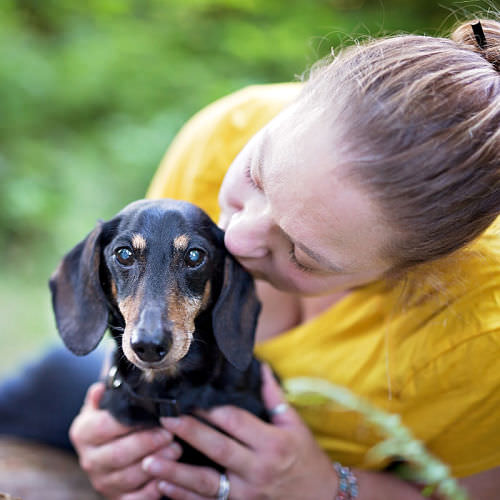
About the Author: Through her 17 years of owning and caring for Dachshunds, and almost 10 years researching and writing about them, JW has become a respected expert in the Dachshund community. Read more about her here.

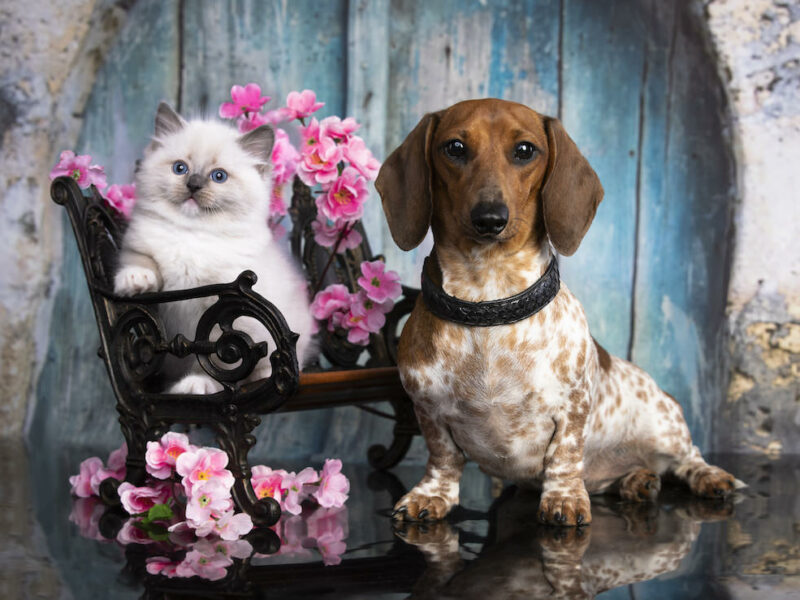






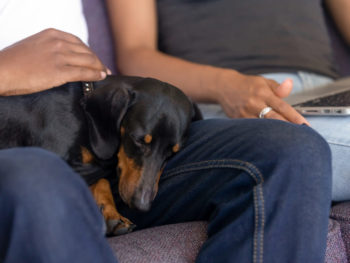


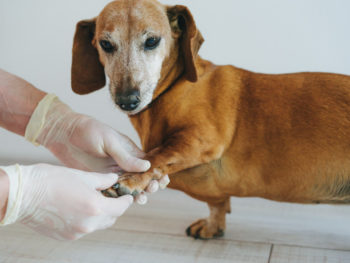

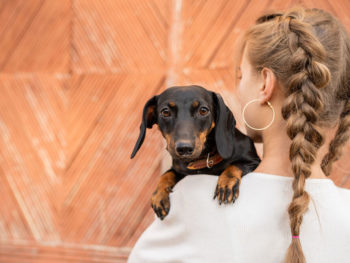
 Are Dachshunds Stubborn?
Are Dachshunds Stubborn?


